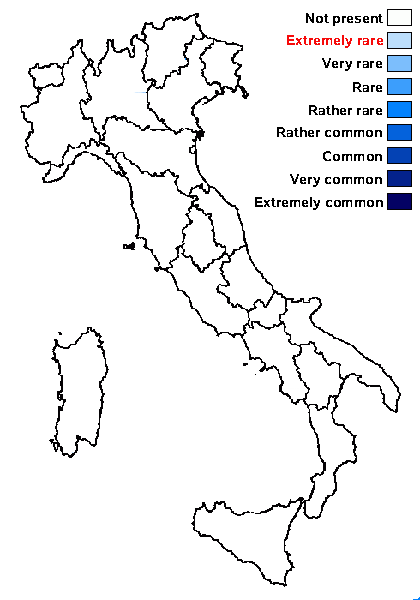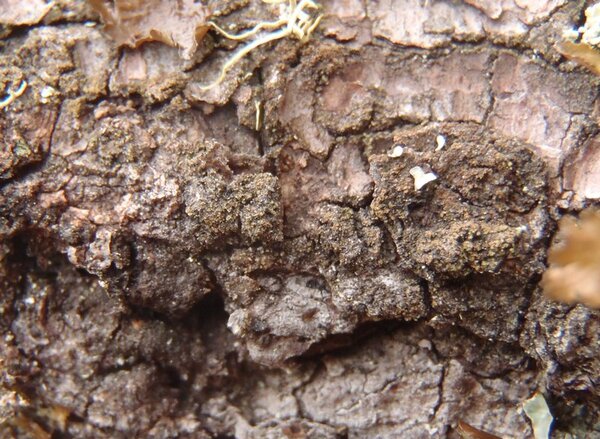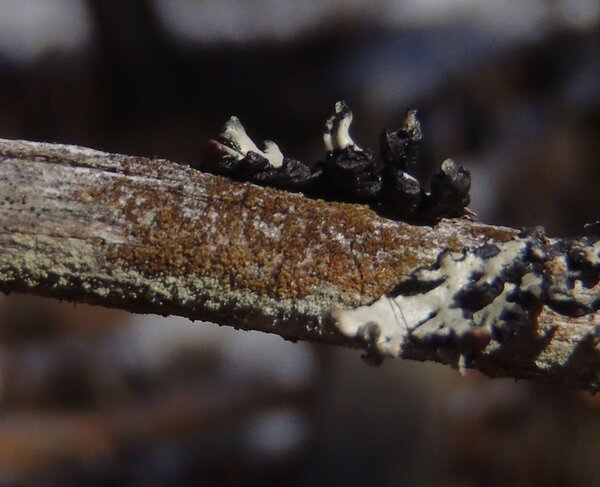Japewia subaurifera Muhr & Tønsberg
in Tønsberg, Lichenologist, 22: 206, 1990
Synonyms:
Distribution:
Description: Thallus crustose, endo- to thinly episubstratic, continuous to areolate, greenish brown, sorediate, forming small, up to 2 cm wide patches which sometimes become confluent, rarely delimited by a thin, brownish prothalline line. Esorediate parts indistinctly areolate, the areoles rounded to irregular in outline, flat to slightly convex, up to 0.15 mm wide. Soralia medium to dark brown externally, bright-coloured, yellow- or orange-brown internally, at first well-delimited, punctiform, more or less convex, up to 0.4 mm across, later often confluent into a thicker, subleprose crust; individual soredia up to 30 µm wide, sometimes aggregated into up to 75 µm wide consoredia; external soredia (blastidia) surrounded by a layer of brown, convex cells, the pigment K+ fuscous brown. Apothecia rare, biatorine, chestnut brown, epruinose, up to 0.4(-0.6) mm across, flat to rarely markedly convex when old, soon immarginate. Proper exciple reduced, weakly gelatinized, of radially arranged, branched and anastomosing hyphae, the outer rim reddish brown and K+ fuscous brown; epithecium reddish brown, K+ fuscous brown; hymenium colourless to yellowish brown, up to 75 µm high, inspersed with oil droplets, K/I-; paraphyses coherent, branched and anastomosing, the apical cells c. 2-5 µm wide, with a brown cap, the pigment deposited outside the cell wall; hypothecium colourless to pale yellowish brown, with yellowish oil droplets. Asci 8-spored, subglobose to broadly ellipsoid, with a well-developed amyloid tholus, a non-amyloid wall and an amyloid outer cap. Ascospores 1-celled, hyaline, ovate-ellipsoid, ellipsoid or subglobose, 11-20 x (8-)12-13(-14) µm, the wall 1.5-3 µm thick, surrounded by a gelatinous perispore. Photobiont chlorococcoid. Spot tests: external soredia K+ fuscous brown, internal soredia K- or K+ pale yellow, P-, C-, KC- or KC+ fleeting pale orange, UV- or UV+ white (in specimens with lobaric acid). Chemistry: xanthones of the secalonic acid-group, eumitrin, sometimes lobaric acid.Note: on acid bark of both broad-leaved and coniferous trees in moist habitats; widespread in the Holarctic region, with a few scattered records from the Alps, outside the Italian territory: to be looked for in the Italian Alps.
Growth form: Crustose
Substrata: bark
Photobiont: green algae other than Trentepohlia
Reproductive strategy: mainly asexual, by soredia, or soredia-like structures (e.g. blastidia)
Most common in areas with a humid-warm climate (e.g. most of Tyrrenian Italy)

Predictive model


Curtis Randall Björk - CC BY-SA 4.0
British Columbia, British Columbia, Clearwater Valley, On dead Alnus, riparian forest. 2014-05-03.
Herbarium: Holotype
Growth form: Crustose
Substrata: bark
Photobiont: green algae other than Trentepohlia
Reproductive strategy: mainly asexual, by soredia, or soredia-like structures (e.g. blastidia)
Most common in areas with a humid-warm climate (e.g. most of Tyrrenian Italy)

Predictive model


 INDEX FUNGORUM
INDEX FUNGORUM
 GBIF
GBIF



